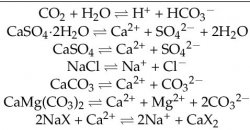Efflorescence

What Is Efflorescence?
What we call whitening in brick; dissolves the soluble salts contained in the bricks when they come into contact with water and transports the salts to the surface of the bricks during the drying of the bricks.
Where Do These Salts Come Into The Brick?
Bricks can contain these salts in two ways.
1) If salts are present in the adhesive and joint sealant material used during the application of the brick and / or within the surface to which it is applied, these salts may dissolve with water and penetrate the structure of the brick; in other words, salt water will be absorbed by the brick. In this way, the salts have reached the structure of the brick and bleaching will occur with drying.
Therefore, care must be taken in the selection of auxiliary materials used.
2) Clay and other auxiliary raw materials used in the production of bricks are the salts found by nature. These salts are normally required to degrade during the sintering of the brick, ie during firing.
However, it is certain that different salts are degraded at different temperatures. If your cooking temperature is insufficient for brick production, not all of the salts are degraded and in practice the brick is doomed to whiten.
The various salts and their decomposition temperatures and the amount of water solubility of 1 liter are given in the table below. As can be seen, there are salts that decompose at different temperatures in the range of 500-1.125 degrees.
Table 1.1 High Soluble Salts in Clay Materials
Salt | Resolution g/lt | Decomposition-Decomposition Temperature |
CaCO3 | 0.015 | 1.000 – 1.125 |
CaSO4 | 2.09 | 1.000 – 1.125 |
CaSO4.2H2O | 2.41 | 750 |
CaMg(CO3)2 | 0.32 | 700 |
MgCl | 542.5 | 700 |
MgCO3 | 0.106 | 750 |
MgSO4 | 260.0 | 851 |
Na2CO3 | 71.0 | 700 |
NaCl | 357.0 | 650 - 700 |
Na2SO4 | 47.6 | 891 (Ergime) |
K2CO3 | 1120.0 | 700 |
KCl | 347.0 | 500 |
K2SO4 | 68.5 | 600 |
How Can The Customer Distinguish This Before Demand?
If the manufacturer fires the bricks at around 1,050 ° C, it cannot degrade the salts and continue to contain the salts in the bricks. However, as can be seen in the table above, in order to ensure the degradation of all soluble salts, a minimum of 1.125 ° C should be applied. In this way, the bricks will not remain in the salt does not decompose.
However, the manufacturer firm in the market is described as field land; technically sintering that firing temperature of 950-1.100 degrees chemical composition and mineral content using a raw material that uses 1.125 degrees and above can not apply to the cooking of salt can not decompose and the brick is doomed to whitening.
For this reason, please ask the relevant companies about the cooking temperatures before you decide to buy the brick.
